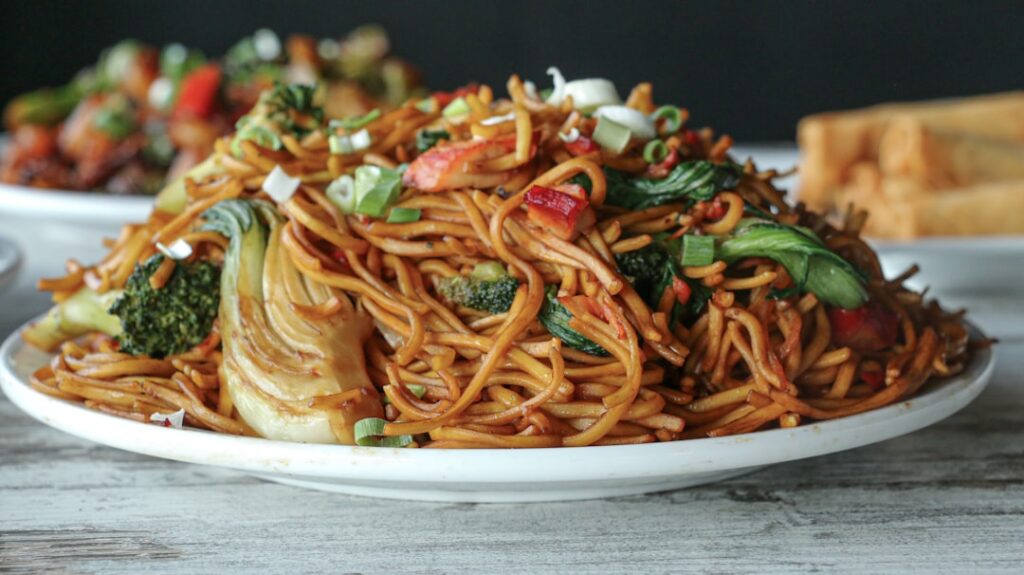Why Chow Mein is the Ultimate Global Comfort Food
Chow mein is one of the world’s most beloved noodle dishes – a simple yet satisfying plate of stir-fried noodles that has traveled far beyond its Chinese origins to become a global comfort food staple.
Quick Chow Mein Facts:
- What it is: Chinese stir-fried noodles with vegetables and often meat or tofu
- Name meaning: “Chow” (炒) = stir-fry, “Mein” (面) = noodles in Cantonese
- Origins: Southern China’s Guangdong province, popularized by Cantonese immigrants
- Key difference: Unlike lo mein, chow mein noodles are stir-fried until slightly crispy
- Global reach: Found on Chinese restaurant menus worldwide with local adaptations
Whether you’re craving the crispy American-Chinese version from your local takeout spot or seeking the authentic Cantonese street food experience, chow mein offers something for every palate. This dish perfectly embodies the story of culinary migration – how simple ingredients like wheat noodles, soy sauce, and fresh vegetables can transform into countless regional variations.
From the jerk-spiced Caribbean “chow” to India’s fiery Hakka-style preparations, chow mein has become a canvas for local flavors while maintaining its essential soul: perfectly stir-fried noodles that deliver comfort in every bite.
For food-loving travelers, understanding chow mein opens doors to authentic dining experiences across cultures. It’s also become a go-to dish for home cooks seeking healthier alternatives to heavy takeout meals.
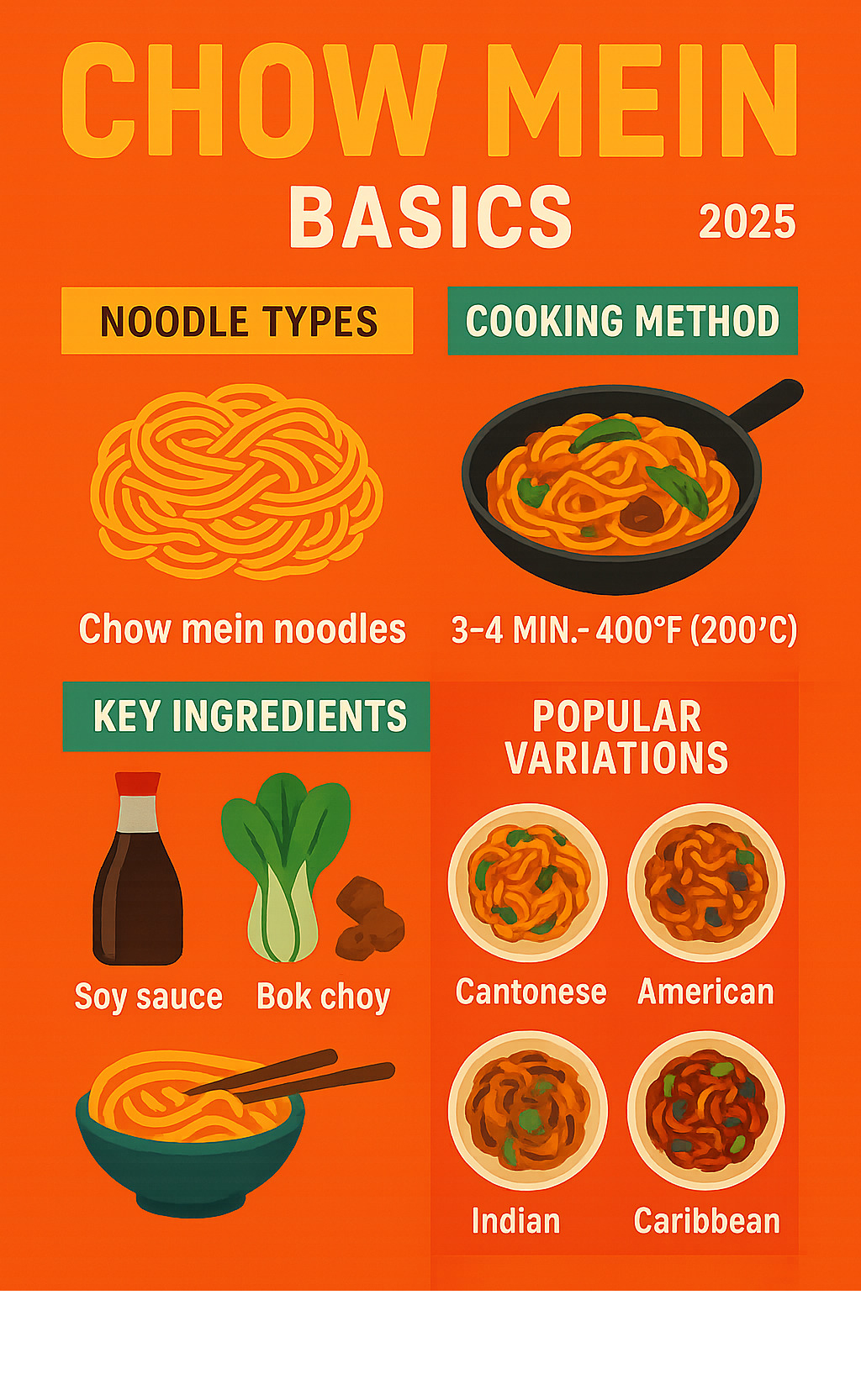
Chow mein terms explained:
Why This Guide Matters
The global food landscape has shifted dramatically in recent years. Food tourism trends show that travelers increasingly seek authentic local experiences rather than generic tourist fare. Meanwhile, the home cooking boom has inspired countless people to recreate restaurant favorites in their own kitchens. Chow mein sits perfectly at this intersection – it’s both a window into authentic Chinese culinary traditions and an accessible dish for home cooks looking for healthier take-out swaps.
We’ve seen home cooks achieve remarkable results with chow mein recipes, with some achieving ratings of 4.97 out of 5 from over 1,000 votes. This tells us that when prepared correctly, homemade chow mein can rival or even surpass restaurant versions while offering better nutritional control and ingredient quality.
Chow Mein 101: History & Etymology
Picture this: the busy streets of Guangdong province in southern China, where the rhythmic clang of woks and the sizzle of noodles hitting hot oil created the soundtrack of daily life. This is where chow mein was born, in the hands of skilled Cantonese cooks who understood that the secret to perfect stir-fried noodles lay in achieving wok hei – literally “the breath of the wok.”
This magical technique involves cooking at blazing high temperatures that create that distinctive smoky flavor and slightly crispy texture we associate with authentic chow mein. It’s not just cooking; it’s culinary alchemy.
The dish’s journey to global fame began with the Toisan diaspora – waves of immigrants from the Taishan region of Guangdong who packed their wok skills and noodle wisdom into their luggage. These culinary pioneers didn’t just bring recipes; they brought a food philosophy that would adapt and evolve across continents.
When chow mein made its official English debut in 1906, it marked more than just a dictionary entry. It represented the beginning of a beautiful cultural exchange. By the 1940s, the dish had become so beloved that entrepreneurs like Jeno Paulucci started canning it for American grocery stores. His clever substitution of celery for water chestnuts wasn’t just cost-cutting – it was culinary innovation that shaped American-Chinese cuisine forever.
The evolution of dishes like chow mein has gained serious recognition in recent years. The 2x James Beard Awards have honored Chinese-American cuisine, acknowledging that these adapted dishes aren’t just “fusion” – they’re legitimate culinary traditions with their own rich stories.
Origins in Southern China
In its homeland, chow mein wasn’t fancy restaurant fare – it was the ultimate street food. Vendors with portable wok burners would whip up steaming bowls of stir-fried noodles for workers, travelers, and anyone craving a quick, satisfying meal.
The magic happened in those portable kitchens where achieving perfect wok hei meant the difference between ordinary noodles and extraordinary chow mein. The technique required split-second timing and scorching heat that most home kitchens couldn’t replicate.
The railroad migration stories of the 19th century tell us how Chinese workers, primarily from Guangdong province, carried these culinary traditions across oceans and continents. They established the first Chinese restaurants in places like California and New York City, introducing Western palates to the smoky, savory world of authentic chow mein.
The Term “chow mein” Across Languages
The linguistic journey of chow mein is as fascinating as its culinary one. In Mandarin, you’ll see it written as chǎo miàn (炒面), but the Cantonese pronunciation “chau meing” sounds much closer to what we say in English today.
Different Romanization systems have created spelling variations like “chow mien” or “chau mein,” but they all point to the same delicious reality: stir-fried noodles that have conquered the world. This linguistic evolution shows how food terms adapt as they cross cultural boundaries, keeping their phonetic soul while fitting into new languages and writing systems.
Global Chow Mein Variations
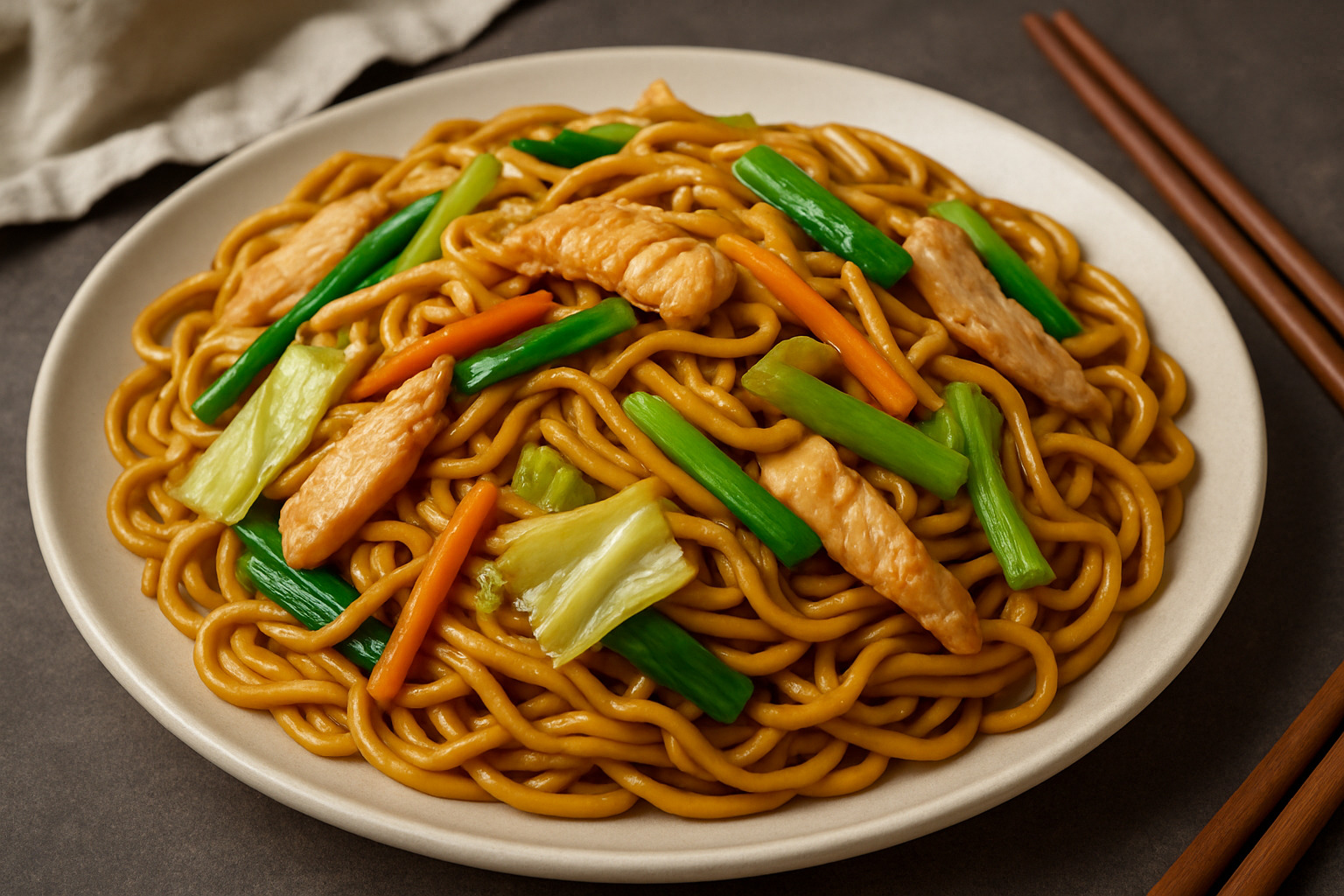
Chow mein has traveled the globe like a culinary ambassador, picking up local flavors and techniques wherever it lands. What started as a simple Cantonese street food has become something beautifully different in every corner of the world.
The magic happens when local cooks take the basic concept – stir-fried noodles with vegetables and protein – and make it their own. In some places, you’ll find versions that would make a Guangdong street vendor nod in approval. In others, the adaptations are so creative they’ve become entirely new dishes with their own devoted followings.
This global change tells the story of how food connects cultures. American Chinese restaurants created their own crispy versions, Indian Hakka cooks added fiery spices, Caribbean Trini chefs brought jerk flavors, and Canadian Prairie style emerged from local preferences. Even Nepalese fast-food joints and Peruvian tallarín saltado show how this humble noodle dish adapts to any cuisine.
For food lovers exploring Chinese Food Near Me, understanding these variations opens up a world of findy. Each regional style reflects the local palate while honoring the dish’s stir-fried soul.
American Crispy vs Steamed Chow Mein
America’s relationship with chow mein created one of the most interesting East versus West Coast food divides in the country. Walk into a Chinese restaurant in Boston versus one in San Francisco, and you might get completely different dishes with the same name.
Crispy chow mein dominates the East Coast, featuring flat noodles fried until they’re crunchy as potato chips, then topped with a thick celery gravy loaded with vegetables and meat. This style emerged from early Chinese-American restaurants that adapted their cooking to match American expectations of what Chinese food should look like.
The West Coast prefers steamed chow mein, using soft, round noodles that are boiled then stir-fried with ingredients. This version stays much closer to traditional Chinese preparation methods, reflecting the stronger cultural connections between West Coast Chinese communities and their homeland.
Perhaps the most uniquely American creation is the chow mein sandwich – a New England specialty where chow mein gets served inside a hamburger bun. It sounds bizarre, but locals swear by this fusion that represents the ultimate Americanization of the dish.
The canned era of the 1940s also shaped American interpretations. When entrepreneurs created shelf-stable versions using celery instead of water chestnuts and Italian spices to appeal to European-American palates, they influenced how entire generations understood Chinese food.
Indo-Chinese Chow Mein Craze
India’s love affair with chow mein has created some of the most exciting and flavorful variations worldwide. Street carts across the country serve up versions that would make traditional Cantonese cooks do a double-take – and probably ask for seconds.
Hakka-style chow mein dominates Indian menus, featuring bold flavors that accept the Indian preference for spicy food. Schezwan spice transforms the mild original into a fiery experience that pairs perfectly with the Indian palate. The real game-changer is the vegetarian dominance – paneer (Indian cottage cheese), mixed vegetables, and creative plant-based proteins have made chow mein accessible to India’s large vegetarian population.
Street vendors have democratized the dish, adapting it to local tastes and budgets. These cooks often incorporate Indian spices and cooking techniques, creating fusion dishes that feel authentically Indian while honoring the stir-fried tradition.
The result is a chow mein that’s distinctly Indian – spicier, more vegetarian-friendly, and perfectly suited to the street food culture that defines so much of India’s culinary landscape.
Caribbean “Chow” Culture
The Caribbean islands have acceptd chow mein with typical island creativity, turning it into something that reflects their vibrant, multicultural food scene. Here, “chow” becomes a canvas for expressing local identity.
Jerk fusion brings Jamaica’s signature spice blend to the noodles, creating a smoky, spicy version that’s uniquely Caribbean. The Guyanese soy flair reflects that country’s Chinese immigrant community, but with local adaptations that incorporate Caribbean flavors and cooking techniques.
In Trinidad and Tobago, Trini eight-treasure style includes a variety of vegetables and proteins that showcase the island’s multicultural food traditions. Local vegetables, different protein combinations, and Caribbean seasoning techniques create versions that are distinctly island-style.
These Caribbean adaptations prove that chow mein works as a vehicle for expressing local identity while maintaining its essential character as a satisfying stir-fried noodle dish. The islands have made it their own, just like everywhere else this traveling dish has landed.
Cooking & Recipes: Mastering Authentic Chow Mein at Home
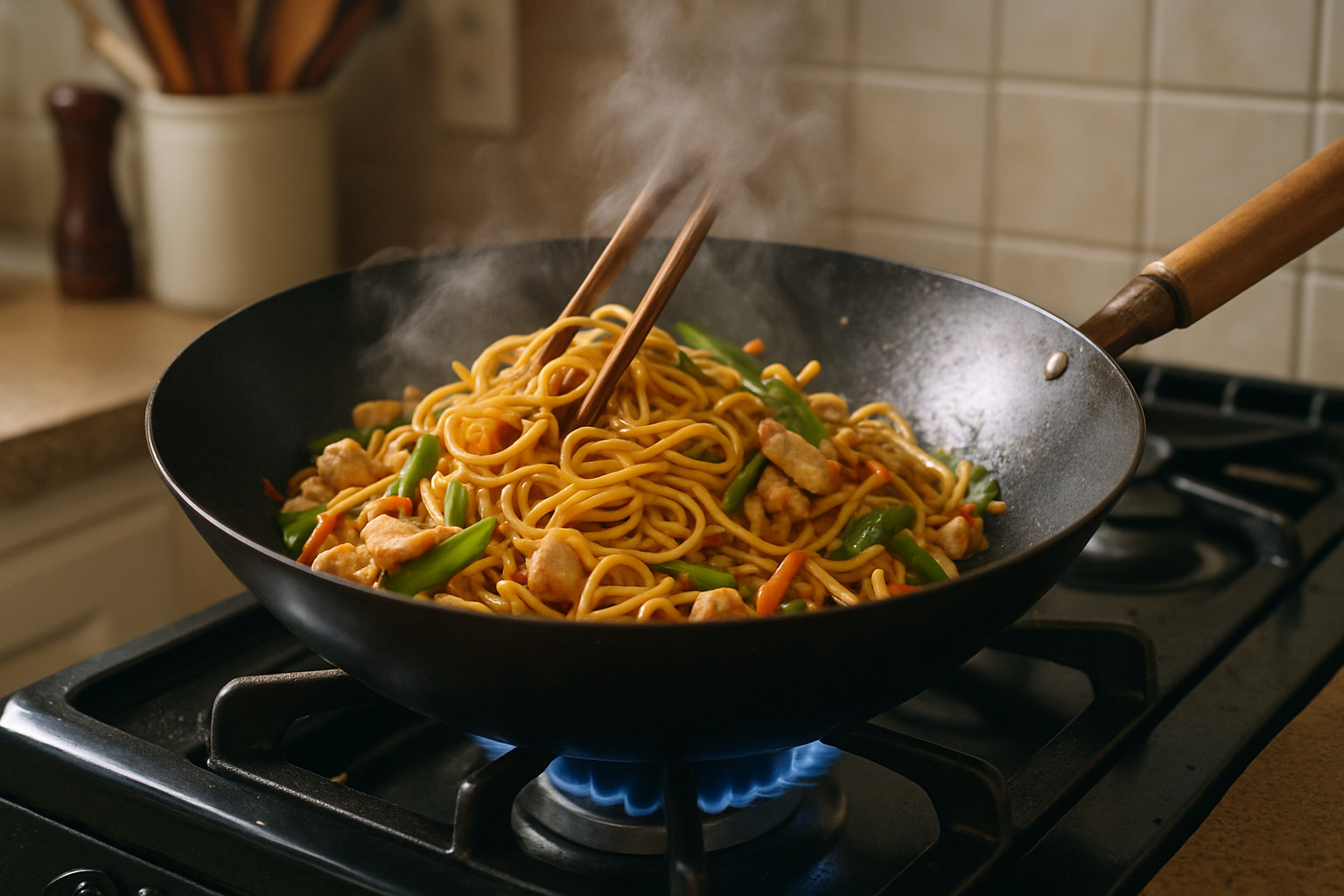
Creating authentic chow mein at home requires understanding both technique and ingredients. The key lies in high-heat cooking, proper noodle preparation, and achieving the perfect balance of flavors and textures. With the right approach, home cooks can create dishes that rival restaurant versions while controlling ingredients and nutritional content.
The foundation of great chow mein starts with classic egg noodles – thin, crinkly noodles that are lightly coated in flour. These noodles have the perfect texture for stir-frying, absorbing flavors while maintaining their structure. When authentic chow mein noodles aren’t available, yakisoba noodles or even thin spaghetti can work as substitutes.
Protein options are virtually limitless. Chicken Recipes work beautifully in chow mein, with chicken thigh preferred over breast for its juiciness. Shrimp, beef, pork, or firm tofu all make excellent choices. The key is cutting proteins into uniform pieces that cook quickly and evenly.
The vegetable medley typically includes cabbage, carrots, celery, and green onions, but the beauty of chow mein lies in its adaptability. Use what’s fresh and available, cutting everything into similar-sized pieces for even cooking.
The sauce is where the magic happens. A proper chow mein sauce balances soy sauce, oyster sauce, a touch of sugar, and sesame oil. Cornstarch acts as a thickener, ensuring the sauce coats the noodles without making them soggy. The sesame oil finish adds that distinctive aroma and richness that makes restaurant-style chow mein so appealing.
Difference Between Chow Mein and Lo Mein
Understanding the difference between chow mein and lo mein is crucial for both cooking and ordering. While both are Chinese noodle dishes, their preparation methods and final textures are distinctly different.
| Aspect | Chow Mein | Lo Mein |
|---|---|---|
| Noodle Type | Thin, crinkly egg noodles | Thick, soft egg noodles |
| Cooking Method | Stir-fried until slightly crispy | Boiled then tossed with sauce |
| Texture | Dry, slightly crispy | Moist, soft |
| Sauce Application | Mixed during stir-frying | Tossed after cooking |
| Appearance | Ingredients distributed throughout | Ingredients often arranged on top |
Chow mein noodles are stir-fried in the wok with other ingredients, creating a dish where everything is integrated. The noodles develop a slight crispiness from the high-heat cooking, and the sauce is absorbed during the stir-frying process.
Lo mein, by contrast, uses thicker noodles that are boiled until tender, then tossed with sauce and ingredients. The result is a moister, softer dish where the noodles remain distinctly separate from the other components.
Chop suey, often confused with both dishes, is actually a different preparation entirely – a stir-fried dish of vegetables and meat that’s served over rice rather than incorporated with noodles.
Crispy vs Soft Chow Mein
The choice between crispy and soft chow mein often depends on regional preferences and cooking techniques. Both styles have their merits and devoted followers.
Crispy chow mein requires a high-heat sear that creates a golden, slightly crunchy exterior while keeping the interior tender. This technique involves par-boiling the noodles briefly, then pan-frying them until they develop color and texture. The sauce is often served alongside or on top rather than mixed in, preserving the noodles’ crispiness.
Soft chow mein focuses on sauce absorption and ingredient integration. The noodles are cooked until tender, then stir-fried with other ingredients and sauce until everything is well combined. This style allows for better flavor distribution and creates a more cohesive dish.
The key to either style is avoiding soggy noodles – the nemesis of good chow mein. Proper noodle preparation, including thorough draining and drying, is essential for success.
Pro Tips & Chef Secrets
Professional chefs who have made chow mein thousands of times over 50+ year careers share several crucial techniques for home success:
Mise en place is absolutely critical. Have all ingredients prepped and ready before heating the wok. Stir-frying happens quickly, and there’s no time to chop vegetables once cooking begins.
Wok hei – the “breath of the wok” – is achieved through extremely high heat and quick cooking. While home stoves can’t match restaurant BTUs, using the highest heat setting and working in batches if necessary helps achieve similar results.
Avoiding soggy noodles requires proper preparation. Rinse cooked noodles under cold water to stop cooking, then drain thoroughly. Some chefs even pat noodles dry with paper towels before stir-frying.
MSG is optional but traditional. Many authentic recipes include a small amount of MSG for umami depth, but it’s easily omitted for those who prefer to avoid it.
Meal-prep storage works well for chow mein. Store components separately when possible, and reheat in a hot pan rather than the microwave to maintain texture.
The cornstarch in the sauce serves multiple purposes – it thickens the sauce, helps it adhere to ingredients, and prevents the noodles from becoming dry during cooking.
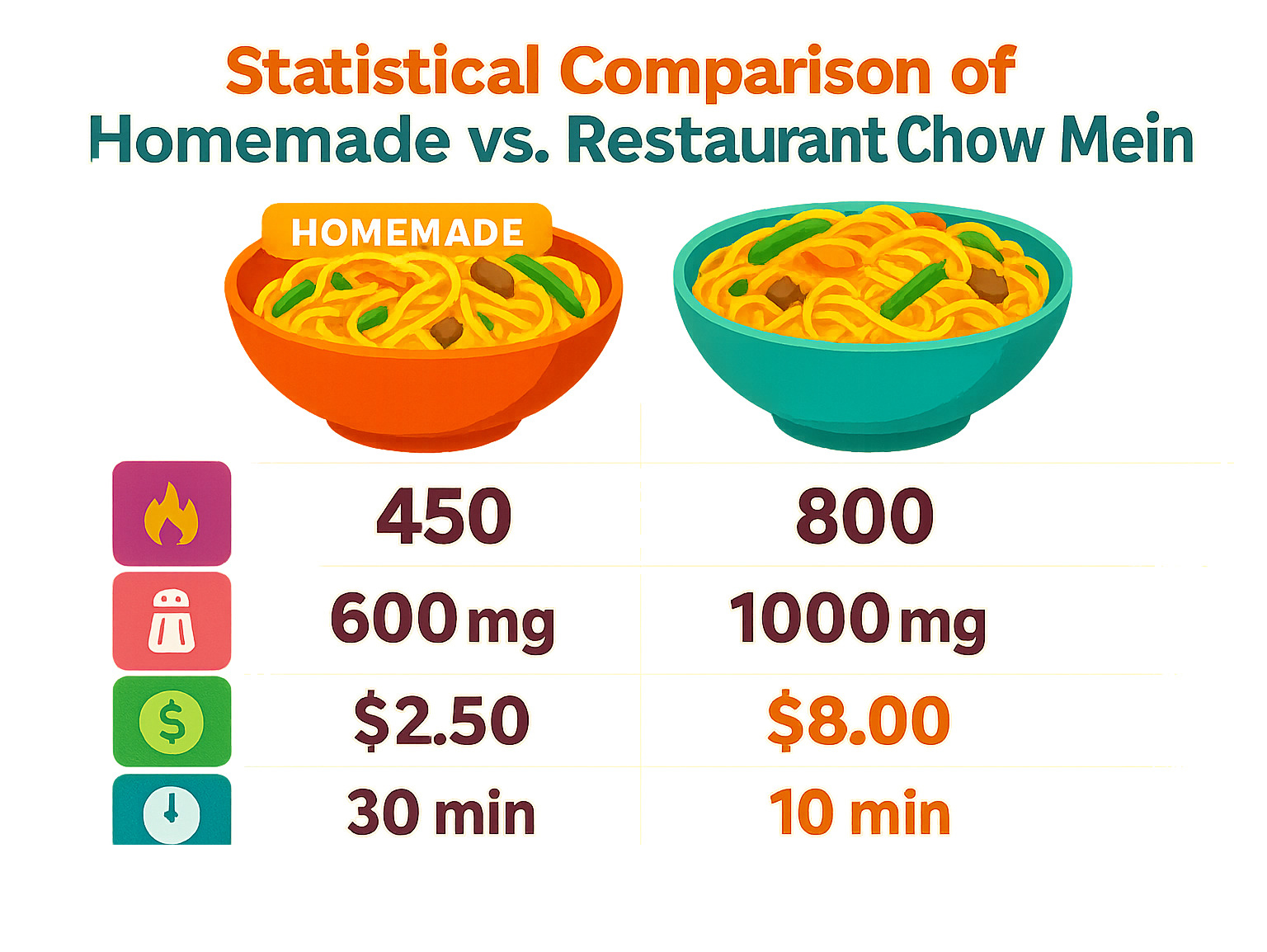
Frequently Asked Questions About Chow Mein
Home cooks often reach out with questions about mastering chow mein in their own kitchens. After helping thousands of food enthusiasts perfect this beloved dish, we’ve noticed the same concerns come up again and again. Let’s tackle the most common questions with practical, honest answers that will help you create restaurant-quality chow mein at home.
Is chow mein unhealthy if eaten often?
The short answer? Chow mein can absolutely be part of a healthy eating pattern when you’re mindful about preparation and portions. A typical homemade serving delivers around 340 calories, 36g of carbohydrates, and 19g of protein – pretty balanced for a satisfying meal.
The real health concern comes from restaurant versions, which can pack up to 699mg of sodium per serving (that’s 30% of your daily limit). All that soy sauce and seasoning adds up quickly! When you make chow mein at home, you control the salt shaker.
Here’s where you can make it healthier: boost those vegetables. Instead of the usual 50-50 noodle-to-veggie ratio, flip it around. Load up on cabbage, carrots, snap peas, and bell peppers. You’ll get more fiber (aim for that 4.4g per serving), more vitamins, and fewer empty calories.
Portion control matters too. Restaurant servings are often enough for two people, but we tend to eat what’s in front of us. A proper serving should leave you satisfied, not stuffed.
Choose lean proteins like chicken breast or firm tofu, and consider whole grain noodles when you can find them. These small swaps can drop the calories to around 327 per serving while keeping all the flavor you love.
Can I make gluten-free chow mein?
Absolutely, and it’s easier than you might think! The key is knowing which ingredients to swap and how to handle them properly.
Rice noodles are your best friend here. Look for thin rice noodles or rice vermicelli – they stir-fry beautifully and have a similar texture to traditional wheat noodles. Just remember they cook differently. Most rice noodles need soaking in hot water rather than boiling, and they can turn mushy if you’re not careful.
Tamari sauce replaces soy sauce perfectly. It’s essentially gluten-free soy sauce with the same rich, salty flavor that makes chow mein so satisfying. Most grocery stores carry it now, usually right next to the regular soy sauce.
Watch out for sneaky gluten sources! Oyster sauce often contains wheat, so grab a gluten-free version or make your own with tamari and a touch of hoisin sauce. Even chicken broth and seasoning blends can hide gluten, so check those labels.
If you’re cooking for someone with celiac disease, cross-contamination is crucial to avoid. Use separate cutting boards, utensils, and make sure your cooking surfaces are thoroughly cleaned. It’s worth the extra effort to keep everyone safe and happy.
What’s the best protein for chow mein?
This question always sparks friendly debates in our community! The truth is, the “best” protein depends on your taste preferences and cooking confidence, but we can share what works reliably well.
Chicken thigh wins our vote for beginners. It stays juicy during high-heat stir-frying (unlike breast meat, which can turn rubbery), and the slightly higher fat content means more flavor. Cut it into uniform pieces and give it a quick marinade with soy sauce and cornstarch – that’s the secret to restaurant-style texture.
Shrimp cooks lightning-fast and pairs beautifully with the light, savory flavors of chow mein sauce. Medium to large shrimp work best, and frozen is totally fine if you thaw and pat them dry first. Add them last to prevent that unfortunate rubber-ball texture.
For our vegetarian friends, firm tofu is fantastic when handled right. Press out the excess moisture (seriously, don’t skip this step), cube it up, and give it a light browning before adding to your stir-fry. Extra-firm tofu holds its shape better and won’t fall apart on you.
Beef flank steak brings rich, savory flavor when sliced thin against the grain. A quick marinade helps tenderize it, and high heat cooking keeps it from getting tough.
The real secret with any protein? Cut everything the same size and time it right. Proteins need the longest cooking time, so get them nearly done before adding your vegetables. This simple timing trick will lift your chow mein game significantly.
Conclusion & Next Culinary Trip
Chow mein represents far more than just a noodle dish – it’s a beautiful story of how food travels, adapts, and brings people together across cultures. From its humble beginnings as Cantonese street food to its current status as a beloved global comfort food, chow mein shows us how simple ingredients can create extraordinary connections when prepared with care and understanding.
We’ve journeyed through the rich history that connects Guangdong province to kitchens around the world, finded how Caribbean spices and Indian flavors have transformed this classic dish into something uniquely their own, and learned the techniques that separate soggy takeout from restaurant-quality results. Whether you’re craving the crispy American-Chinese version or seeking the authentic wok hei of traditional preparation, chow mein offers endless possibilities for culinary exploration.
The real magic of chow mein lies in its welcoming nature. It accepts local ingredients with open arms, accommodates dietary restrictions without complaint, and scales effortlessly from quick weeknight dinners to elaborate feast preparations. For home cooks, it provides a friendly entry point into Chinese cooking techniques, while for food tourists, it offers a delicious lens through which to understand cultural migration and adaptation.
As you start on your own chow mein trip, the best versions come from understanding both tradition and innovation. Respect the fundamental techniques – the high heat, the proper noodle preparation, the careful balance of flavors – while embracing the creative possibilities that have made this dish beloved from street carts in Mumbai to family kitchens in New York City.
At The Dining Destination, we celebrate these noodle heritage traditions that connect us across cultures and continents. Every bowl of chow mein tells a story of migration, adaptation, and the universal human desire for comfort and connection through food. Whether you’re cooking at home or exploring authentic preparations around the world, you’re participating in a culinary tradition that spans generations and brings the global palate together in the most delicious way possible.
Ready to explore more global comfort foods that tell similar stories of cultural exchange and culinary creativity? Check out our Best Food Destinations guide for your next tasty journey, where you’ll find how beloved dishes like chow mein connect us to the rich mix of world cuisine and the endless possibilities for delicious trips.

